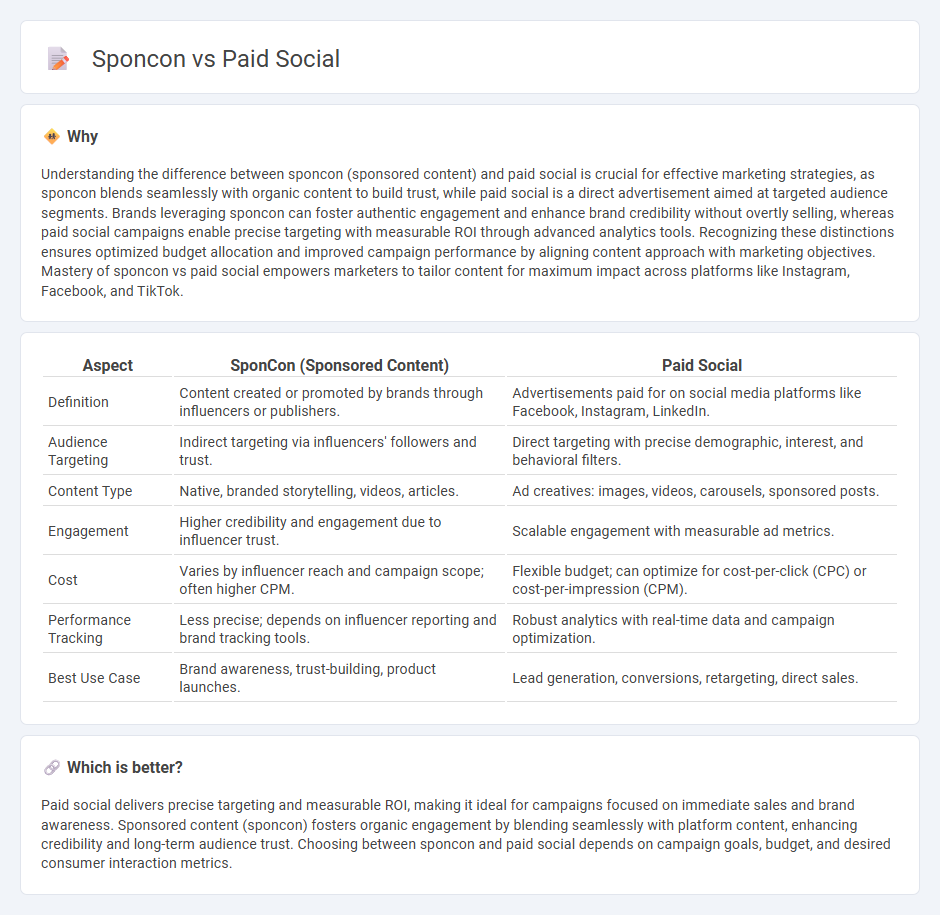
Sponsored content integrates brand messages seamlessly within relevant media to engage audiences authentically, while paid social involves targeted ads on platforms like Facebook and Instagram to drive immediate conversions. Both strategies leverage data analytics and audience segmentation to maximize ROI and brand visibility across digital channels. Explore how sponcon and paid social can complement each other for a cohesive marketing campaign.
Why it is important
Understanding the difference between sponcon (sponsored content) and paid social is crucial for effective marketing strategies, as sponcon blends seamlessly with organic content to build trust, while paid social is a direct advertisement aimed at targeted audience segments. Brands leveraging sponcon can foster authentic engagement and enhance brand credibility without overtly selling, whereas paid social campaigns enable precise targeting with measurable ROI through advanced analytics tools. Recognizing these distinctions ensures optimized budget allocation and improved campaign performance by aligning content approach with marketing objectives. Mastery of sponcon vs paid social empowers marketers to tailor content for maximum impact across platforms like Instagram, Facebook, and TikTok.
Comparison Table
| Aspect | SponCon (Sponsored Content) | Paid Social |
|---|---|---|
| Definition | Content created or promoted by brands through influencers or publishers. | Advertisements paid for on social media platforms like Facebook, Instagram, LinkedIn. |
| Audience Targeting | Indirect targeting via influencers' followers and trust. | Direct targeting with precise demographic, interest, and behavioral filters. |
| Content Type | Native, branded storytelling, videos, articles. | Ad creatives: images, videos, carousels, sponsored posts. |
| Engagement | Higher credibility and engagement due to influencer trust. | Scalable engagement with measurable ad metrics. |
| Cost | Varies by influencer reach and campaign scope; often higher CPM. | Flexible budget; can optimize for cost-per-click (CPC) or cost-per-impression (CPM). |
| Performance Tracking | Less precise; depends on influencer reporting and brand tracking tools. | Robust analytics with real-time data and campaign optimization. |
| Best Use Case | Brand awareness, trust-building, product launches. | Lead generation, conversions, retargeting, direct sales. |
Which is better?
Paid social delivers precise targeting and measurable ROI, making it ideal for campaigns focused on immediate sales and brand awareness. Sponsored content (sponcon) fosters organic engagement by blending seamlessly with platform content, enhancing credibility and long-term audience trust. Choosing between sponcon and paid social depends on campaign goals, budget, and desired consumer interaction metrics.
Connection
Sponsored content (sponcon) and paid social are interconnected marketing strategies that leverage social media platforms to increase brand visibility and engagement. Brands use sponcon to create authentic, engaging posts through influencers or native advertising, while paid social amplifies this content via targeted ads on platforms like Facebook, Instagram, and LinkedIn. Together, these tactics optimize reach and conversion by combining organic influence with precise audience targeting and data-driven ad spend.
Key Terms
Advertising Spend
Paid social advertising often commands a larger portion of marketing budgets due to its precise targeting capabilities and measurable ROI, driving higher engagement on platforms like Facebook, Instagram, and LinkedIn. Sponsored content (sponcon) generally involves native placements that blend with editorial content, offering subtle brand exposure but typically requiring less spend than paid social campaigns. Explore detailed comparisons of advertising spend strategies to optimize your marketing investments effectively.
Influencer Collaboration
Paid social campaigns leverage targeted ads on platforms like Facebook and Instagram to rapidly scale brand visibility, while sponsored content (sponcon) involves influencer collaborations that create authentic, engaging narratives. Influencer collaborations provide valuable social proof and credibility by tapping into established follower trust, enhancing brand connection through personalized content. Discover how integrating paid social with influencer sponcon can maximize your marketing ROI and audience impact.
Branded Content
Branded content in paid social campaigns leverages authentic storytelling to enhance brand visibility and engage targeted audiences through native ad placements on platforms like Facebook and Instagram. Sponsored content (sponcon) typically integrates seamlessly with organic posts, boosting reach while maintaining a natural user experience, which improves brand recall. Explore further to understand how branded content strategies can maximize ROI and foster deeper consumer connections.
Source and External Links
Paid Social: Top Platforms and Tips for Effective Social Media Ads (2024) - Paid social is a digital marketing strategy where businesses pay social platforms to show ads to targeted audiences based on demographics and interests, offering guaranteed visibility on feeds like Facebook and TikTok and various payment models such as cost-per-mille or cost-per-click.
The Complete Guide to Paid Social: Trends & Predictions (2025) - Paid social advertising in 2024 largely emphasizes video content, AI-powered personalized targeting, evolving platform dynamics, and the integration of social commerce to enhance the shopping experience directly on social media.
Paid Social Solution Overview - Skai - Skai offers a centralized platform to manage paid social campaigns across major networks like Facebook, Instagram, TikTok, Pinterest, and LinkedIn, with tools for data integration, algorithmic optimization, bulk ad management, and multi-campaign scaling for effective paid social marketing.
 dowidth.com
dowidth.com